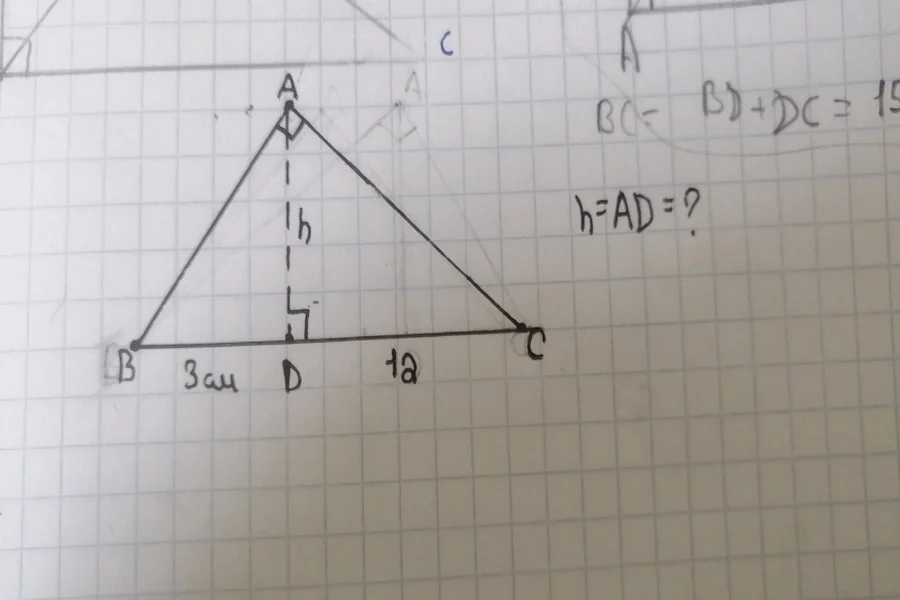Understanding how to find the height of a triangle is essential in geometry. The ability to comprehend this measure is central whether you are completing a piece of schoolwork, resolving real-life issues, or exploring architectural design. Height, or altitude of a triangle, is a very useful concept for measuring area and studying shapes. This topic can be quite confusing for many students and professionals, but using the right approach, it can be made relatively easy.
The methods used to find the height of a triangle in this article will vary depending on the type of triangle being considered. Whether you are dealing with simple right-angled triangles or complicated scalene ones, you will find clear explanations that can make you excel in such geometric abilities. Perhaps you are working with formulas, drawing perpendiculars, or using trigonometric identities, we will simplify it all for you in an easy manner.
What is the height of a triangle?
Before learning how to find the height of a triangle, it’s important to understand what it is. In geometry, the height of a triangle represents the perpendicular distance between a vertex (a corner of the triangle) and the line through the opposite side (which is regarded as a base). It angles 90 degrees with the base, whether the triangle is a right-angle triangle, obtuse, or acute.
Unless the triangle is a right triangle, the height is not necessarily one of the sides of a triangle. On the other kinds of triangles, the height should be in or even beyond the triangle, according to its form. Such a value plays a significant role in the determination of the area, which is determined using the following formula:
Area = ½ × base × height
After knowing the area and base, you can rearrange the formula to find the height. This is useful in instances when it is difficult to make a direct measurement.
Using the area formula
One of the most common ways how to find the height of a triangle is by using the area formula. When you have the area and the base, it is easy to find the height. Rearranging the formula mentioned earlier, the height becomes:
Height = (2 × Area) ÷ base
To give an example, should a triangle have an area of 24 square units and a base of 6 units in length, the height captured would be:
Height = ( 2 x 24 )/ 6 = 48/ 6 = 8 units
This is a good method of tackling any triangle, provided you have the base and the area.
Right triangle method
When working with a right triangle, learning how to find the height of a triangle becomes more straightforward. In a right triangle, one of the legs (shorter sides) is already perpendicular to the bottom. Either leg may be taken as the height, according to the side adopted as the base.
An example of this is when you have a 3-unit and a 4-unit triangle, where the big angle of the triangle is right, and when you use three as your base, 4 is the height. The area would be:
Area = ½ × 3 × 4 = 6 square units
There is no need for additional drawing or calculation in this, as the height is already apparent.
Using trigonometry
The height of a triangle, or rather triangles, can also be calculated through trigonometric functions, particularly when you know either the angle or one side. This method is particularly useful for non-right triangles. When you have the length of a side and an angle, the sine function enables you to compute the height.
Height = side × sin(angle)
An example is when a triangle has a side of 10 units and the angle opposite the base is 30 degrees; then, how high is the base?
Height = 10 sin (30 )=10 sin (0.5) = 10 x 0.5 = 5 units
Using trigonometry is an efficient way how to find the height of a triangle when you don’t have the area or perpendicular lines directly available.
Using Heron’s formula
The Heron formula is quite feasible in scalene triangles, provided that all three sides are known. First, calculate the area using Heron’s formula:
s = (a + b + c) / 2
Area = √[s(s – a)(s – b)(s – c)]
Then you can take the area to determine the height similarly to before. This technique is a bit longer, but it’s a great example of how to find the height of a triangle when you have only the sides and no angles or perpendiculars.
Drawing the height manually
Drawing the height is sometimes necessary, for example, when conducting a practical exercise or drawing a diagram. First, find the base, and then take a ruler or a triangle scale and draw a line perpendicular to the opposite vertex of the base. This gives you a visual representation of the height.
This does not always provide exact numerical values, but it does offer a clear representation of what the height will look like and its position within the triangle. This hands-on method is ideal for geometry students learning the basic concept of how to find the height of a triangle.
Real-life applications
Understanding how to find the height of a triangle has numerous practical applications in real-world settings. Architects use it when designing roofs and structures. Surveyors use it to measure land and buildings. Engineers need it to calculate stress and load. Artists and even graphic designers apply this knowledge in creating a balanced composition.
Whether it is space, volume, or visual dimensions, this basic geometric principle is significant in most disciplines.
Common mistakes to avoid
When learning how to find the height of a triangle, students often confuse the base and height or try to measure slanted sides as height. The height should also always be perpendicular to the base. And do not suppose that the longest side is the base; such a side may be the base, in the right entirely, provided the height is taken properly as the distance of the opposite vertex.
The other error is the use of an inappropriate angle or side during trigonometric methodologies. It is always important to know the values assigned and what is wanted before deciding on the method to use.
FAQs
How do you find the height of a triangle from its area and base?
You can use the formula: Height = (2 × Area) ÷ base. This is the most direct method for finding the height of a triangle when the area and base are known.
Can you find the height of a triangle without the area?
Yes, you can use trigonometric functions or the Pythagorean theorem in certain triangles, especially if angles or side lengths are given.
How do I find the height of a scalene triangle?
Use Heron’s formula to calculate the area and then apply the standard height formula: Height = (2 × Area) ÷ base.
Is the height always inside the triangle?
No, in obtuse triangles, the height can fall outside the triangle when extended from a vertex to the opposite side.
Why is height important in triangles?
Height is necessary for finding the area, analyzing shape properties, and solving geometric problems efficiently.





